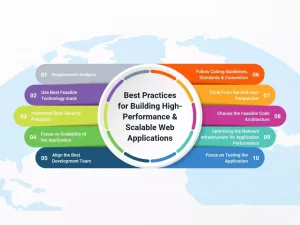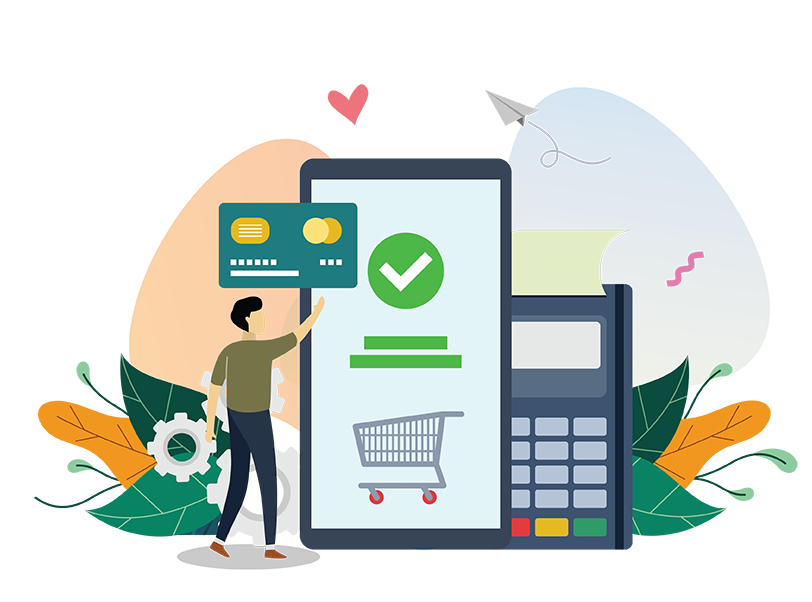Imagine this: you’ve developed a fintech or eCommerce application after painstakingly studying user requirements, adding features that perfectly meet their needs, and wrapping it all in an eye-catching design. After tirelessly promoting it, your app finally hits the market.
Initially, the downloads skyrocket, but soon, you notice a troubling trend: the numbers start to dwindle. After some investigation, your software testing team identifies the issue—scalability problems leading to performance issues.
The importance of building scalable applications cannot be overstated. A well-designed app can provide businesses with:
- A change-ready ecosystem
- Positive user experiences
- Cost savings through resource optimization
- Higher ROI potential
To achieve these benefits, it’s crucial to design your app with scalability in mind. At TechDotBit, we’re here to help you future-proof your business.
In this article, we’ll explore the key aspects of scalability in app development to ensure your app can handle future growth.
When Should You Start Worrying About App Scalability?
Scalability in app development means building an app that can handle increased workloads or user demand—like high traffic, more data storage, or higher computational requirements—without compromising performance.
Here are some signs that it’s time to think about scalability:
- Rising Performance Issues: Slow load times, constant timeouts, or frequent system errors suggest your app is struggling under heavy workloads.
- Resource Overload: If your system is always operating at peak capacity (CPU, memory, storage, network), it can lead to frequent downtime and performance dips.
- High Traffic Peaks and Network Latency: Increased latency during high user loads indicates your app has outgrown its infrastructure, causing service degradation.
- Business Scaling: If you’re planning to introduce new features or enter new markets, app scalability becomes essential for meeting growing demands and supporting business growth.
How Can You Scale Your Application?
Once you’ve decided it’s time to scale, here are your options:
1. Vertical Scaling
Vertical scaling means boosting your server’s capacity with more CPU power, storage, or memory. This approach works well for small apps but has hardware upgrade limits.
2. Horizontal Scaling
Horizontal scaling spreads operational workloads across multiple servers or instances. This popular method is ideal for large apps with many users, ensuring smooth operations.
3. Microservices
Microservices break your app into individual services, each scalable independently. This approach lets you scale specific parts of your app as needed.
4. Serverless
Serverless architecture eliminates maintenance concerns by handling scaling automatically. It’s cost-efficient and perfect for unpredictable workloads.
Tips for Building a Scalable Mobile Application
At TechDotBit, we follow these essential practices for scalable mobile app development:

1. Scale Data Storage
Optimizing software before hardware is crucial. Efficient database queries and write operations save money and manage more users. An effective cache layer can help achieve more with fewer resources.
2. Scale File Storage
Plan for distributed file storage using cloud services. Make sure to calculate expected bandwidth to avoid surprise costs.
3. Optimize for Traffic
Avoid bottlenecks with DNS rotation and load balancing techniques like Kubernetes’ built-in load balancer or Amazon Elastic Load Balancer.
4. Prepare for New Markets
Focus on localization, including language support, cultural elements, and legalities. Utilize CDN services to deliver static content quickly.
5. Efficient Data Management
Implement scalable database solutions like MongoDB or Cassandra. Use database optimization techniques to ensure fast data access and maintain performance.
6. Plan for Infrastructure Scalability
Use cloud-based solutions like Google Cloud’s Compute Engine or AWS EC2. Implement orchestration with Kubernetes and containerization with Docker for smooth scaling.
7. Understand Your User Base
Gather user-centric data to prioritize features and ensure the app aligns with evolving user needs.
Tips for Building a Scalable Web Application
Scalability in web applications depends on design, resources, traffic patterns, APIs, and code optimization. Here are our essential practices for scalable web app development:
1. Select the Best Hardware
Choose resources that support the expansion of distributed database services. Monitor key metrics like memory and CPU utilization to determine scalability needs.
2. Opt for Microservices Architecture
Microservices allow scaling of necessary components without affecting the entire application, unlike monolithic architectures.
3. Introduce Caching
Use caching to store data temporarily, reducing query time and providing faster data access.
4. Use Load Balancers
Implement load balancers to optimize traffic distribution and ensure fast processing.
5. Select the Right Database
Choose databases based on data types. For relational data, use Microsoft SQL, MySQL, or PostgreSQL. For unstructured data, opt for NoSQL databases like MariaDB or MongoDB.
6. Adopt an API-first Approach
Make APIs a modular part of web development. API gateways merge requests and route them to correct endpoints, reducing interactions between the app and users.
7. Build Multi-tier Software Architecture
Divide the app into several tiers, each running on multiple hardware, making scalability easier and cost-effective.
Overcoming Challenges in Building Scalable Applications
Here are some common challenges and how we address them at TechDotBit:
- Unscalability of Current Architecture: We migrate to microservices for easy deployment and scaling.
- Data Inconsistency: Implement efficient data synchronization approaches.
- Resource Constraints: Continuously track and optimize resource usage. Invest in scalable cloud infrastructure.
- Security Vulnerabilities: Follow secure coding practices, regular security assessments, and strong authorization mechanisms.
- High Scalability Costs: Strategize scaling based on actual usage trends to balance cost and performance efficiency.
Case Study: Scaling a Fintech Application
A Canada-based fintech startup approached us for web and mobile app development. We built a scalable architecture capable of handling huge traffic loads. The MVP was developed in two weeks using Storybook and React Native. As demand grew, we transitioned the backend to React, enabling easy code sharing between the website and mobile app. Today, the app has over 1 million downloads with no performance issues.
Partner with TechDotBit to streamline your app scalability process and future-proof your business.
FAQs
Q: What is application scalability? A: Application scalability refers to the ability of an app to handle increased workload or user demand without compromising performance.
Q: Why build a scalable app? A: Scalable apps handle sudden growth, maintain performance, offer cost efficiency, future-proof the business, and provide a competitive advantage.
Q: How to scale an application? A: Scale web applications using microservices architecture, caching, the right database, and an API-first approach. For mobile apps, scale data and file storage, optimize for traffic, manage data efficiently, and plan for infrastructure scalability.
Partner with TechDotBit to scale your business efficiently and effectively.








